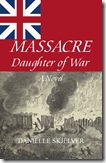 Skjelver, Daniell Mead. Massacre: Daughter of War. Rugby, ND: Goodwyfe Press, 2003.
Skjelver, Daniell Mead. Massacre: Daughter of War. Rugby, ND: Goodwyfe Press, 2003.
Danielle Mead Skjelver wrote a very skilful novel weaving her family history within the larger events in colonial America during the seventeenth and early eighteenth centuries, including the tumultuous events of King Phillip’s War (1675-76) and Queen Anne’s War (1702-13). Beginning with the 1637 destruction of the Pequot Fort, the book traces the Hawks/Scott family and its place within the larger Anglo-French conflicts as well as conflicts with Native Americans. Several characters stand out within the story: Sergeant John Hawks, Hannah Scott (the Sergeant’s daughter), Jonathan Scott (Hannah’s husband), John Scott (Hannah’s son), Honors The Dead (a fictional Mohawk warrior), and Red Bear (Honors The Dead’s son-in-law). All of these characters relate to each other as the story progressed and indict Puritan life along the way.
The story of Honors The Dead is a truly remarkable one when considered against Sergeant John Hawks and his family. Taken captive when very young, Honors The Dead witnessed the destruction of his birthplace in 1637, where Sergeant John Hawks’ father participated in the massacre of the Pequot residing there. Honors The Dead sees the Sergeant’s father looking down at him after the death of Honors The Dead’s father, which allowed the boy to see the unique features of the Hawks family, their blue eyes (described as ice blue) and blonde hair. As he grew into manhood among a rival people, Honors The Dead sought revenge against the one he perceived killed his father.
Meanwhile, the Hawks family continued the tradition of serving in the military, as Sergeant John Hawks participated in King Phillip’s War. War was a way of life more than just serving in it, as Hawks soon found out. When Queen Anne’s War erupted in the colonies, Hawks’ daughter Hannah was living in Connecticut Colony raising a young family, while a remarried John lived in Deerfield, Massachusetts Colony. Tragedy struck the Sergeant’s family, as the Deerfield Raid in 1704 claimed several members to outright murder and captivity. Despite this, Hawks begins to recover, living with Hannah and her family. An uneasy peace settles over the family, as they go about the routine of Puritan life, while Red Bear continues on the warpath and avenging his father-in-law’s loss of his first wife and daughters at the hands of the English, including Sergeant Hawks.
Tragedy strikes Hannah’s family as her brother-in-law is tortured and killed by Indians, while Jonathan, and her two oldest sons, John and Jonathan Jr. (known by Junior in the book) are taken captive by Red Bear and his war party. The book then addresses the hardships of captivity, including running the gauntlet and internal conflict within a boy.
While all the main characters are captivating, the character of young John Scott, who is captured at the age of eleven truly stands out. Skjelver described the nature of Puritan life quite well, including the many negatives. Poor John, who was left-handed, was treated harshly in his Puritan community, as they viewed this trait as a predilection towards devil worship and evil. While his grandfather, John Hawks, is a little more gentle with the boy, his Puritan beliefs do surface on occasion. The boy tries hard to please those he loves, but he excelled in areas viewed as bad by Puritans. His father, Jonathan Scott, while initially appearing as a loving father, later comes across as a hard, uncompromising man, a sharp contrast to his mother Hannah, who seems to recognize her son’s unique characteristics, but is prevented from nurturing him to the fullest by the constraints of society. Through Skjelver’s portrayal, one sees the attraction of the open frontier versus the unbending harshness of Puritans.
Young John Scott comes across as a pseudo-Hawkeye, as he is drawn to the wild of the woods and becomes a skilled hunter, which draws the attention of Red Bear. Upon entering captivity, readers will feel the strong conflict within John’s soul, as he takes to Indian life, where he is accepted for who he is. John’s story forces readers to reflect upon their own faith, character traits that may contrast with their community, and how they might handle such a situation. Through the story of the Hawks/Scott family, Hannah is truly a “daughter of war”, suffering such loss that few women could endure.
Danielle Skjelver’s prose was solid, descriptive, and truly captured the cruelties of warfare and the strength of the human spirit. Given her current graduate study in History, it is no doubt that she will one day make her mark in historical scholarship. Though the story is different and involves an earlier period, Massacre: Daughter of War is a wonderful fictional account based around real events and serves as a twenty-first century model of Last of the Mohicans.
